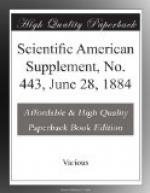While the cloud was electrified, it acted inductively on the earth underneath, drawing up an opposite charge from all points, and thus electrifying the atmosphere. When the discharge occurs this atmospheric electrification engages with the earth, clearing the air between, and driving the dust and germs on to all exposed surfaces. In some such way also it may be that “thunder turns milk sour,” and exerts other putrefactive influences on the bodies which receive the germs and dust from the air.
But we are now no longer on safe and thoroughly explored territory. I have allowed myself to found upon a basis of experimental fact, a superstructure of practical application to the explanation of the phenomena of nature and to the uses of man. The basis seems to me strong enough to bear most of the superstructure, but before being sure it will be necessary actually to put the methods into operation and to experiment on a very large scale. I hope to do this when I can get to a suitable place of operation. Liverpool fogs are poor affairs, and not worth clearing off. Manchester fogs are much better and more frequent, but there is nothing to beat the real article as found in London, and in London if possible I intend to rig up some large machines and to see what happens. The underground railway also offers its suffocating murkiness as a most tempting field for experiment, and I wish I were able already to tell you the actual result instead of being only in a position to indicate possibilities. Whether anything comes of it practically or not, it is an instructive example of how the smallest and most unpromising beginnings may, if only followed up long enough, lead to suggestions for large practical application. When we began the investigation into the dust-free spaces found above warm bodies, we were not only without expectation, but without hope or idea of any sort, that anything was likely to come of it; the phenomenon itself possessed its own interest and charm.
And so it must ever be. The devotee of pure science never has practical developments as his primary aim; often he not only does not know, but does not in the least care whether his researches will ever lead to any beneficial result. In some minds this passive ignoring of the practical goes so far as to become active repulsion; so that some singularly biased minds will not engage in anything which seems likely to lead to practical use. I regard this as an error, and as the sign of a warped judgment, for after all man is to us the most important part of nature; but the system works well nevertheless, and the division of labor accomplishes its object. One man investigates nature impelled simply by his own genius, and because he feels he cannot help it; it never occurs to him to give a reason for or to justify his pursuits. Another subsequently utilizes his results, and applies them to the benefit of the race. Meanwhile, however, it may happen that the yet unapplied and unfruitful results evoke a sneer, and the question: “Cui bono?” the only answer to which question seems to be: “No one is wise enough to tell beforehand what gigantic developments may not spring from the most insignificant fact.”




